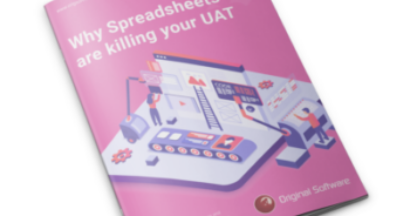Hands up if you’ve ever had to outsource software testing? Obviously, given that this is a blog, I can’t see whether your hand was up – but I’m willing to bet that lots of you have outsourced your software testing capabilities in the past – either in part, or completely. And often for what feel like good reasons:
- You don’t have the expertise in-house to run software testing at scale
- You don’t have the time to do it alongside everything else that needs doing
- You want the peace of mind that someone else is taking care of it
- It’s cheaper than hiring dedicated testing resource
In this blog, we’re going to gently poke at those ideas. Because we believe that, with the right tools, you can actually test faster, better, and more cheaply by doing it in-house.

What do you mean, “the right tools”?
In our experience, most software testing – especially User Acceptance Testing (UAT) – is managed via a combination of spreadsheets, emails, screenshots, and hope. For those doing automated testing, add another software programme to the list – as well as a lot of complex coding, depending on how good your test automation software is. When organizations only had to test a few updates a year, this was OK – but now that cloud platforms are pushing updates to organizations quarterly or even monthly, existing testing processes are getting messy, and things are starting to fall through the cracks.
We’re advocates of using purpose-built and fit-for-purpose software to get a handle on software testing at scale. In particular, tools that:
- Let you manage automated and manual testing together
- Simplify test creation and management
- Integrate with developer tools to effectively move work between developers and testers
Now that we’re clear on that, let’s test those assumptions about outsourcing.

Lacking expertise? Get a tool that anyone can use.
Typically, the types of expertise that you’d go to an outsourcer for can be described as:
- Familiarity with the process – after all, testing companies do testing day in, day out.
- The ability to create automated test scripts and manual testing instructions.
- Experience guiding business users through any manual testing phases they need to do.
With the right tools, though, these tasks can be done by your own people quickly and easily. You can even bring user acceptance testing back in-house, removing the hassle and risk of getting a third party to pose as your own business users for testing.
What’s important is that you invest in a tool that’s intuitive and simple for both test managers and business users. You also want to find a tool that can show you the status of your testing at a glance. With those things in place, anyone can step into the role of test manager with ease, and business users can conduct tests without the need for excessive coaching or support.
The test creation piece is where lots of people stumble – after all, even code-free solutions can be quite complex depending on how customized your systems are. Fortunately for our customers, automated test creation really is simple when you use our tools. You can even do it just by recording a user going about their work. The same goes for creating manual tests. And, because of this, it’s also very easy and intuitive for users to take tests. They just do the things they normally do!

Testing doesn’t have to be time-consuming
OK – it’s true that outsourcing will often free up time for your in-house employees to focus on other things. However, bringing testing back in-house may not eat up as much of your team’s time as you think. And, given that the time you save is always going to be balanced against the cost of outsourcing, if you can make testing fast enough, the cost of outsourcing may start to become unattractive.
The greatest time-sinks for testing are generally managing the test library, the administration and ongoing management of tests, and ensuring that feedback from users is triaged and passed to developers. The right tools can drastically reduce the time those take. In fact, our UAT solution has been proven to deliver software 60% faster than traditional testing methods. Here’s how it works:
- Because test management is centralized, test admin and management is far quicker. No more hunting through emails or combing spreadsheets for the information.
- The way we administer tests makes it easier for test users to give meaningful feedback in context. Test managers can triage that feedback better, and developers can actually see what the problem is. The days of asking users to replicate problems for developers are over.
Think of it this way – if you knew that you could speed up testing by 60%, how much could you save by getting your employees to run testing instead of outsourcing?

Nobody gives you peace of mind like you can
A lot of people like to outsource to trusted parties because it feels safe. And we get that. Getting testing wrong can bring a company to a complete halt and, given the pressures we know application delivery teams are under, handling things in-house might feel too risky. But, if you can develop a mature and robust in-house software testing process, then you might feel even safer than you do right now. After all, outsourcing isn’t without its risks. You’re not directly managing the team, you don’t know them, and they may not know your business as well as you’d like – which could lead to crucial elements getting missed during testing cycles, especially if you’re outsourcing the user role in UAT.
All the things we’ve already talked about give you much greater control over your testing than managing it through spreadsheets and emails ever could. The right tools let you see EXACTLY what tests have been done, which ones are due, and what’s happening with the feedback from completed tests. In our software, for instance, you can even drill down to look at individual test results.
On top of that, our test automation software takes a unique approach in that it shows you EVERYTHING that’s changed in your software. It can even adapt scripts mid-test if your software has changed significantly enough that traditional scripts would break. So, by using the right tools, you can definitely feel totally secure in the quality of your testing while keeping it in-house.

The right tools pay for themselves
From everything we’ve discussed, it’s clear that a software testing platform like ours can get testing done far better and faster than organizations have ever been able to manage before. What that translates into, of course, is the ability to do testing in-house without having to hire platoons of staff, and using your own business users who fully understand the processes you’re trying to test. And that totally changes the equation when evaluating hiring against outsourcing.
While outsourcers can be relied upon to err on the side of overstaffing a project, tools that give you complete visibility and control of your testing allow you to hire exactly the right resource to get the job done (or manage it within your existing team).
In fact, most of our customers say that our software pays for itself before the end of the first project. Everything after that, as they say, is gravy. Or icing on the cake, depending if you’re more of a dessert person.

Time for outsourcing to get out?
If you’re wondering whether your outsourced software testing is really giving you value for money, you should definitely take a closer look at Original Software. Our testing solutions are designed specifically to make software testing faster, easier, and more effective – making it possible to deliver world-class testing entirely in-house. That includes:
- Business process documentation that can be used to quickly and easily create manual and automated tests
- A manual testing solution that makes it easier and quicker for testers to give meaningful feedback
- Automated testing that enables true regression testing and beats just about any other solution on the market in terms of completeness of testing and ease of use
- A UAT solution that, as we’ve said, reduces the effort of UAT by up to 60%
- A test management solution that keeps everything in one place, making management much simpler and providing an automatic audit trail of everything your testing teams are up to
If you’d like to explore bringing your testing back in-house with us, we’d love to talk – just click below to contact us.











